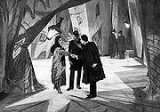
German Expressionism
Overview
German Expressionism refers to a number of related creative movements beginning in Germany
before the First World War that reached a peak in Berlin
, during the 1920s. These developments in Germany were part of a larger Expressionist
movement in north and central European culture in fields such as architecture
, painting
and cinema
.
Among the first Expressionist films, The Student of Prague
(1913), The Cabinet of Dr. Caligari
(1920), The Golem: How He Came Into the World
(1920), Destiny (1921), Nosferatu (1922), Phantom
(1922), Schatten
(1923), and The Last Laugh (1924), were highly symbolic and stylized.
The German Expressionist movement was largely expanded down to the isolation Germany was in during World War I.
Germany
Germany , officially the Federal Republic of Germany , is a federal parliamentary republic in Europe. The country consists of 16 states while the capital and largest city is Berlin. Germany covers an area of 357,021 km2 and has a largely temperate seasonal climate...
before the First World War that reached a peak in Berlin
1920s Berlin
The Golden Twenties in Berlin was a vibrant period in the history of Berlin, German history, and European history in general.-Weimar culture:...
, during the 1920s. These developments in Germany were part of a larger Expressionist
Expressionism
Expressionism was a modernist movement, initially in poetry and painting, originating in Germany at the beginning of the 20th century. Its typical trait is to present the world solely from a subjective perspective, distorting it radically for emotional effect in order to evoke moods or ideas...
movement in north and central European culture in fields such as architecture
Architecture
Architecture is both the process and product of planning, designing and construction. Architectural works, in the material form of buildings, are often perceived as cultural and political symbols and as works of art...
, painting
Painting
Painting is the practice of applying paint, pigment, color or other medium to a surface . The application of the medium is commonly applied to the base with a brush but other objects can be used. In art, the term painting describes both the act and the result of the action. However, painting is...
and cinema
Film
A film, also called a movie or motion picture, is a series of still or moving images. It is produced by recording photographic images with cameras, or by creating images using animation techniques or visual effects...
.
Among the first Expressionist films, The Student of Prague
The Student of Prague (1913 film)
The Student of Prague is a 1913 German silent horror film. The film was remade in 1926, 1935, and 2004 under the same title The Student of Prague.-Plot:...
(1913), The Cabinet of Dr. Caligari
The Cabinet of Dr. Caligari
The Cabinet of Dr. Caligari is a 1920 silent horror film directed by Robert Wiene from a screenplay by Hans Janowitz and Carl Mayer. It is one of the most influential of German Expressionist films and is often considered one of the greatest horror movies of the silent era. This movie is cited as...
(1920), The Golem: How He Came Into the World
The Golem: How He Came Into the World
The Golem: How He Came Into the World is a 1920 silent horror film by Paul Wegener. It was directed by Carl Boese and Wegener, written by Wegener and Henrik Galeen, and starred Wegener as the golem. The script was adapted from the 1915 novel The Golem by Gustav Meyrink...
(1920), Destiny (1921), Nosferatu (1922), Phantom
Phantom (1922 film)
Phantom is a silent film that was directed by F. W. Murnau the same year Murnau directed Nosferatu. It is an example of German Expressionist film and has a surreal, dreamlike quality.-Plot summary:The film is told in an extended flashback...
(1922), Schatten
Schatten - Eine nächtliche Halluzination
Schatten – Eine nächtliche Halluzination is a 1923 German silent film directed by Arthur Robison. It is considered part of German Expressionism.-Plot:...
(1923), and The Last Laugh (1924), were highly symbolic and stylized.
The German Expressionist movement was largely expanded down to the isolation Germany was in during World War I.
Unanswered Questions

